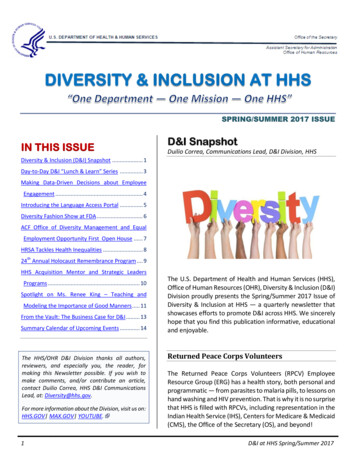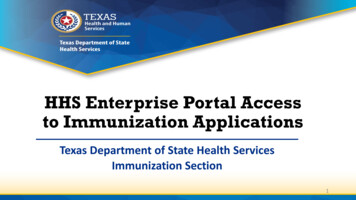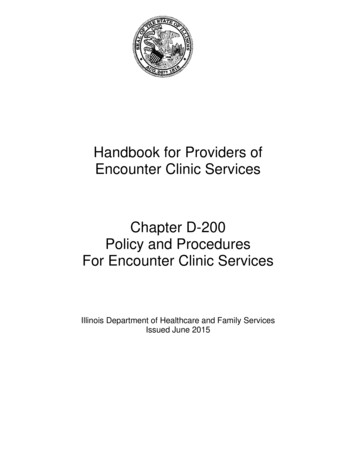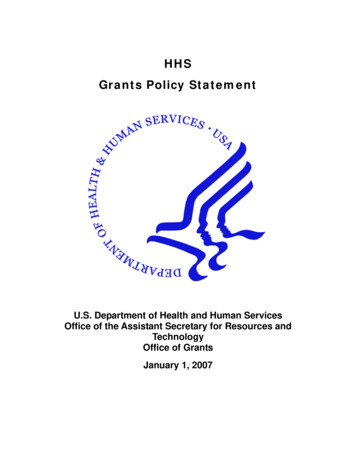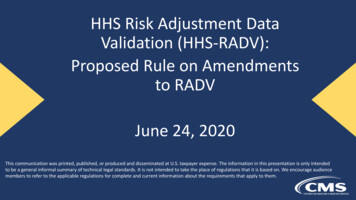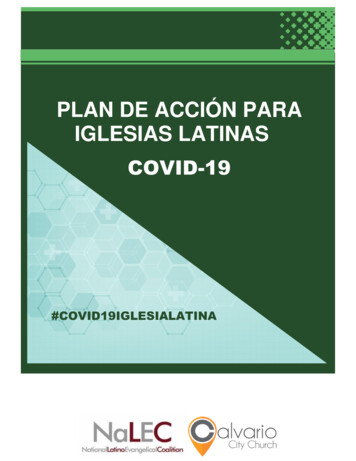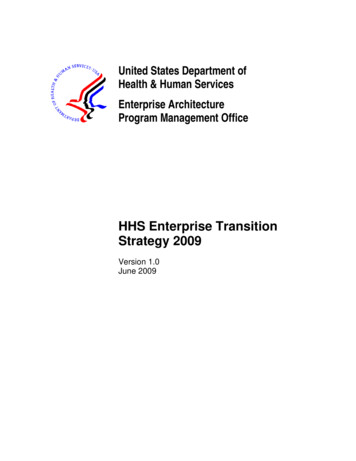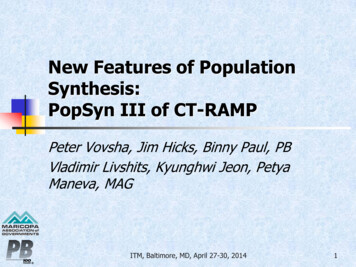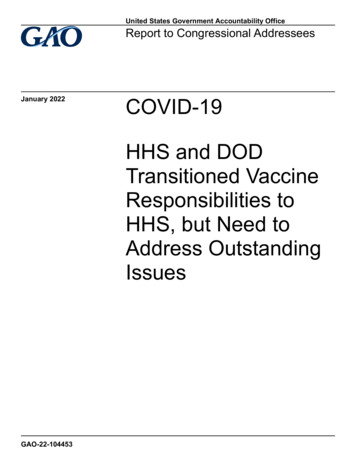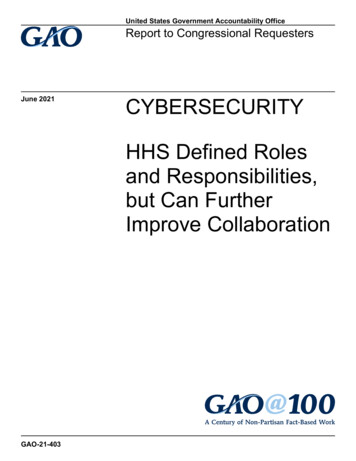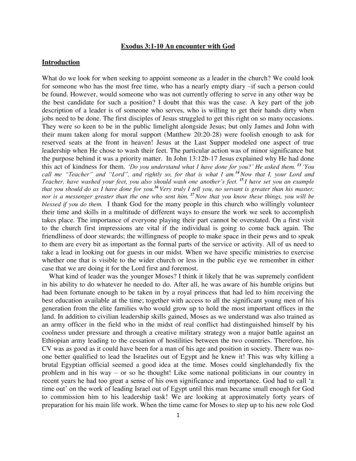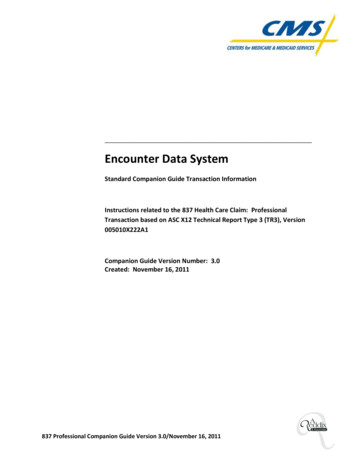
Transcription
Encounter Data SystemStandard Companion Guide Transaction InformationInstructions related to the 837 Health Care Claim: ProfessionalTransaction based on ASC X12 Technical Report Type 3 (TR3), Version005010X222A1Companion Guide Version Number: 3.0Created: November 16, 20111837 Professional Companion Guide Version 3.0/November 16, 2011
PrefaceThe Encounter Data System (EDS) Companion Guide contains information to assist Medicare AdvantageOrganizations (MAOs) and other entities in the submission of encounter data. The EDS CompanionGuide is under development and the information in this version reflects current decisions and will bemodified on a regular basis. All versions of the EDS Companion Guide are identified by a version numberwhich is located in the version control log on the last page of the document. Users should verify theyare using the most current. Questions regarding the contents of the EDS Companion Guide should bedirected to eds@ardx.net.2837 Professional Companion Guide Version 3.0/November 16, 2011
Table of Contents1.0Introduction1.1Scope1.2Overview1.3Major Updates1.3.1 CAS Segment1.3.2 Atypical Provider Default Values1.4References2.0Contact Information2.1CSSC2.2eds@ardx.net2.3Applicable websites/email3.0File Submission3.1File Size Limitations3.2File Structure4.0Control nsaction Specific Information5.1837-P Transaction Specific Table6.0Acknowledgements and/or Reports6.1TA16.29996.3277CA7.0Front-End Edits7.1Permanently Deactivated Front-End Edits7.2Temporarily Deactivated Front-End Edits8.0Duplicate Logic8.1Header Level8.2Detail Level9.0Appendices9.1Business Scenarios – Under Development9.2Data String Example – Under Development9.3File Map – Under Development3837 Professional Companion Guide Version 3.0/November 16, 2011
1.0Introduction1.1ScopeThe CMS Encounter Data System (EDS) Companion Guide for the 837-P transactions addresses howMAOs and other entities conduct Professional claim HIPAA standard electronic transactions with CMS.CMS’ Encounter Data transaction system supports transactions adopted under HIPAA, as well asadditional supporting transactions described in this guide.The CMS EDS Companion Guide must be used in conjunction with the associated 837-P ImplementationGuide (TR3). The instructions in the CMS EDS Companion Guide are not intended to be a stand-alonerequirements document.1.2OverviewThe CMS EDS Companion Guide includes information needed to begin and maintain communicationexchange with CMS. The information is organized in the sections listed below: Contact Information: This section includes telephone and fax numbers for EDS contacts. Control Segments/Envelopes: This section contains information needed to create the ISA/IEA,GS/GE, and ST/SE control segments for transactions to be supported by EDS. Acknowledgements and Reports: This section contains information on all transactionacknowledgements sent by EDS, including the TA1, 999, and 277CA. Transaction Specific Information: This section describes how X12N Implementation Guides (IGs)adopted under HIPAA will be detailed with the use of a table. The tables contain a row for eachsegment with CMS specific information in addition to the information in the IGs. Thatinformation can contain:oooooLimits on the repeat of loops, or segmentsLimits on the length of a simple data elementSpecifics on a sub-set of the IG’s internal code listingsClarifications of the use of loops, segments, composite and simple data elementsAny other information tied directly to a loop, segment, and composite or simple dataelement pertinent to trading electronically with CMS.In addition to the row for each segment, one (1) or more additional rows are used to describe EDS’usage for composite or simple data elements and for any other information.4837 Professional Companion Guide Version 3.0/November 16, 2011
1.3Major Updates1.3.1CAS SegmentMAOs and other entities were previously instructed to populate the following values to indicate anencounter is a correction/replacement or deletion of a previously submitted encounter in the EncounterOperational Data Store: Loop 2300, REF01 ’F8’ and REF02 ICNLoop 2300, CLM05-3 ’7’ (Correct/Replacement) or CLM05-3 ’8’ (Deletion)Loop 2320, CAS01 ’CR’ (Correct/Replace) or CAS01 ’OA’ (Delete), CAS02 ’223’, and CAS03 theamount affected by the correction/replacement or deletion encounter.Upon further review of technical specifications and testing, MAOs and other entities are now instructedto populate the following values to indicate an encounter is a correction/replacement or deletion of apreviously submitted encounter in the Encounter Operational Data Store: Loop 2300, REF01 ’F8’ and REF02 ICNLoop 2300, CLM05-3 ’7’ (Correct/Replacement) or CLM05-3 ’8’ (Deletion)NOTE: MAOs and other entities are not required to populate the CAS segment to indicate acorrection/replacement or deletion of a previously submitted encounter.1.3.2Atypical Provider Default ValuesIn order to submit atypical provider encounters, it may be necessary for MAOs and other entities tosubmit default values in order for the encounter to process correctly through the Encounter Data FrontEnd System and the Encounter Data Processing and Pricing System. MAOs and other entities werepreviously instructed to submit specific default NPIs; however, the default NPI provided in Table 6, Loop2010AA, NM109 should be used.Atypical provider encounters will not be used for risk adjustment purposes, but will be stored and usedfor analytic purposes.1.4ReferencesMAOs and other entities must use the ASC X12N IG adopted under the HIPAA AdministrativeSimplification Electronic Transaction rule along with CMS’ Encounter Data Participant Guides, and CMS’EDS Companion Guidelines for development of EDS transactions. These documents are accessible at thefollowing location: www.csscoperations.comAdditionally, the EDS submitter guidelines and application, testing documents, 5010 companion guides,and Encounter Data Participant Guides can be found at that location.5837 Professional Companion Guide Version 3.0/November 16, 2011
MAOs and other entities must use the most current national standard code lists applicable to the 5010transaction. The code lists may be accessed at the Washington Publishing Company (WPC) website:http://www.wpc-edit.comThe applicable code lists are as follows: Claim Adjustment Reason CodeClaim Status Category CodesClaim Status CodesCMS provides X12 5010 file format technical edit spreadsheets for the 837-I and 837-P. The editsincluded in the spreadsheet are intended to clarify the WPC instructions or add Medicare specificrequirements. In order to determine the implementation date of the edits contained in thespreadsheet, MAOs and other entities will first need to refer to the spreadsheet version. The version isa 10 character identifier as follows: Positions 1-2 indicate the line of business:o EA – Part A (837-I)o EB – Part B (837-P)Positions 3-6 indicate the year (e.g. 2011)Position 7 indicates the release quarter montho 1 – January releaseo 2 – April releaseo 3 – July releaseo 4 – October releasePositions 8-10 indicate the spreadsheet version iteration number (e.g. V01-first iteration, V02second iteration)The effective date of the spreadsheet is the first calendar day of the release quarter month. Theimplementation date is the first business Monday of the release quarter month. Federal holidays whichcould potentially fall on the first business Monday must be accounted for when determining theimplementation date. For example, the edits contained in a spreadsheet version of EB20113V01 areeffective July 1, 2011 and will be implemented on July 5, 2011.2.0Contact Information2.1The Customer Service and Support Center (CSSC)The Customer Service and Support Center (CSSC) personnel are available for questions from 8:00A.M. –7:00P.M. EST, Monday-Friday, with the exception of federal holidays and can be contacted at 1-877-534CSSC (2772).6837 Professional Companion Guide Version 3.0/November 16, 2011
2.2Applicable websites/emailThe following websites provide information to assist in EDS submission:ResourceEncounter Data ParticipantGuidesEDS EmailANSI ASC X12 TR3Implementation GuidesWashington Publishing CompanyHealth Care Code SetsCMS Edits Spreadsheet3.0File Submission3.1File Size LimitationsWeb /20 TechnicalDocumentation.aspDue to system limitations, the combination of all ST-SE transaction sets per file cannot exceed certainthresholds depending upon the connectivity method of the submitter. FTP and NDM users cannotexceed 85,000 encounters per file. Gentran users cannot exceed 5,000 encounters per file. For allconnectivity methods, the TR3 allows no more than5000 CLMS per ST-SE. The following demonstratesthe limits due to connectivity methods:ConnectivityFTP/NDMGentranMaximum Number ofEncounters85,0005,000Maximum Number of ST-SE5,0005,000Note: Due to system processing overhead associated with smaller numbers of encounters within theST-SE, it is highly recommended that larger numbers of encounters within the ST-SE be used.In an effort to support and provide the most efficient processing system, it is recommended that FTPsubmitters’ scripts should not upload more than one (1) file per five (5) minute interval to allowmaximum performance. Files that are zipped should contain one (1) file per transmission. MAOs andother entities should refrain from submitting multiple files within the same transmission.3.2File Structure80 byte fixed block is a common mainframe term. This means every line (record) in a file must beuploaded as 80 bytes/characters long. NDM/Connect Direct and Gentran submitters must use thisapproach.7837 Professional Companion Guide Version 3.0/November 16, 2011
Files should be created in a manner where the segments are one continuous stream of information thatcontinues to the next line every 80 characters.Segments should be stacked in the file, using only 80 characters per line. Using the Enter key or CarriageReturn in position 81 will ensure no more than 80 bytes/characters are contained in each record. If thelast line in the file does not fill to 80 bytes/characters, it should be spaced out to position 80 and thensave the file. Do not use the Enter key or Carriage Return at the end of the last record because this willcreate an additional blank record at the end of the file.For example the ISA record is 106 characters long:ISA*00**00**ZZ*ENH99994* *00501*000000031*1*P*: *ZZ*80882*120430*114The first line of the file will contain the first 80 characters of the ISA segment, the last 26 characters ofthe ISA segment will be continued on the second line. The next segment will start in the 27th positionand continue until column 80.4.0Control Segments/Envelopes4.1ISA-IEAThe term interchange denotes the ISA-IEA envelope that is transmitted. Interchange control is achievedthrough several “control” components, as defined in Table 2. The interchange control number iscontained in data element ISA13 of the ISA segment. The identical control number must also occur indata element IEA02 of the IEA segment. All elements in the ISA-IEA interchange must be populated.There are several elements within the ISA-IEA interchange that must be populated specifically forencounter data purposes. Table 2 below provides EDS Interchange Control (ISA-IEA) specific elements.Note: Only those elements that provide specific details relevant to encounter data are presented in thetable. When developing the encounter data system, users should base their logic on the highest level ofspecificity. First, consult the WPC/TR3. Second, consult the CMS edits spreadsheets. Third, consult theEncounter Data Companion Guide. If there are options expressed in the WPC/TR3 or the CEM editsspreadsheet that are broader then the options identified in the Encounter Data Companion Guide, therules identified in the Encounter Data Companion Guide must be used.8837 Professional Companion Guide Version 3.0/November 16, 2011
LegendSHADED rows represent segments in the X12N Implementation GuideNON-SHADED rows represent data elements in the X12N Implementation GuideTABLE 1 – ISA-IEA INTERCHANGE ELEMENTSLoop angeControl nformationInterchange IDQualifierCodes0000ZZISA06InterchangeSender IDISA07Interchange IDQualifierZZISA08InterchangeReceiver IDRepetitionSeparator80882ISA11Notes/CommentsNo authorizationinformationpresentUse 10 blankspacesNo securityinformationpresentUse 10 blankspacesCMS expects tosee a value of “ZZ”to designate thatthe code ismutually definedEN followed byContract IDNumberCMS expects tosee a value of “ZZ”to designate thatthe code ismutually defined 9837 Professional Companion Guide Version 3.0/November 16, 2011
TABLE 1 – ISA-IEA INTERCHANGE ELEMENTS (CONTINUED)Loop IDReferenceISA13NameInterchange Control e IndicatorIEA02Interchange Control TrailerInterchange Control NumberIEA4.2Notes/CommentsMust be a fixed length withnine (9) characters andmatch IEA02InterchangeAcknowledgementRequested (TA1)A TA1 will be sent if the file issyntactically incorrect,otherwise only a ‘999’ will besent.TestProductionTPMust match the value inISA13GS-GEThe functional group is outlined by the functional group header (GS segment) and the functional grouptrailer (GE segment). The functional group header starts and identifies one or more related transactionsets and provides a control number and application identification information. The functional grouptrailer defines the end of the functional group of related transaction sets and provides a count ofcontained transaction sets.All elements in the GS-GE functional group must be populated. There are several elements within theGS-GE that must be populated specifically for encounter data collection. Table 3 provides EDS functionalgroup (GS-GE) specific elements.Note: Only those elements that require explanation are presented in the table.TABLE 2 - GS-GE FUNCTIONAL GROUP ELEMENTSLoop IDGSReferenceGS02GS03NameFunctional Group HeaderApplication Sender’sCodeApplication Receiver’sCodeCodesNotes/Comments80882EN followed byContract NumberThis value mustmatch the valuein ISA0810837 Professional Companion Guide Version 3.0/November 16, 2011
TABLE 2 - GS-GE FUNCTIONAL GROUP ELEMENTS (CONTINUED)Loop IDReferenceGS06NameGroup Control NumberGS08Version/Release/Industry 005010X222A1Identifier CodeFunctional Group TrailerGroup Control NumberGEGE024.3CodesNotes/CommentsThis value mustmatch the valuein GE02This value mustmatch the valuein GS06ST-SEThe transaction set (ST-SE) contains required, situational, and unused loops, segments, and dataelements. The transaction set is outlined by the transaction set header (ST segment) and thetransaction set trailer (SE segment). The transaction set header identifies the start and identifies thetransaction set. The transaction set trailer identifies the end of the transaction set and provides a countof the data segments, which includes the ST and SE segments. There are several elements that must bepopulated specifically for encounter data purposes. Table 5 provides EDS transaction set (ST-SE) specificelements.Note: Only those elements that require explanation are presented in the table.TABLE 3 - ST-SE TRANSACTION SET HEADER AND TRAILER ELEMENTSLoop IDReferenceSTST01ST02ST03NameTransaction SetHeaderTransaction SetIdentifier CodeTransaction SetControl Comments837This value mustmatch the value inSE02005010X222A111837 Professional Companion Guide Version 3.0/November 16, 2011
TABLE 3 - ST-SE TRANSACTION SET HEADER AND TRAILER ELEMENTS (CONTINUED)Loop IDReferenceSESE01SE025.0NameTransaction SetTrailerNumber ofIncludedSegmentsCodesNotes/CommentsMust contain theactual number ofsegments withinthe ST-SEThis value must bematch the value inST02Transaction SetControl Number837 Professional: Data Element TableWithin the ST-SE transaction set, there are multiple loops, segments, and data elements that providebilling provider, subscriber, and patient level information. MAOs and other entities should referencewww.wpc-edi.com to obtain the most current Implementation Guide. EDS transactions must besubmitted using the most current transaction version.The 837 Professional Data Element table identifies only those elements within the X12N ImplementationGuide that require comment within the context of EDS submission. Table 6 identifies the 837Professional Implementation Guide by loop name, segment name and identifier, and data elementname and identifier for cross reference. Not all data elements listed in the table below are required, butif they are used, the table reflects the values CMS expects to see.TABLE 4 - 837 PROFESSIONAL HEALTH CARE CLAIMLoop nning of HierarchicalTransactionOriginator ApplicationTransaction IdentifierClaim IdentifierSubmitter NameEntity Type QualifierSubmitter IdentifierCodesCH2Notes/CommentsMust be a unique identifieracross all filesChargeableNon-Person EntityEN followed by ContractNumber12837 Professional Companion Guide Version 3.0/November 16, 2011
TABLE 4 - 837 PROFESSIONAL HEALTH CARE CLAIM (CONTINUED)Loop ID1000AReferencePERPER031000APER05Communication NumberQualifierPERSubmitter EDI ContactInformationCommunication NumberQualifierPER071000B2010AANameSubmitter EDI ContactInformationCommunication NumberQualifierNM1NM102NM103NM109Receiver NameEntity Type QualifierReceiver NameReceiver IDNM1NM108Billing Provider NameBilling Provider IDQualifierBilling Provider IdentifierNM109CodesTEEMN4N403It is recommended that MAOsand other entities populatethe submitter’s telephonenumberIt is recommended that MAOsand other entities populatethe submitter’s email addressFXIt is recommended that MAOsand other entities populatethe submitter’s fax number2Non-Person EntityEDSCMSIdentifies CMS as the receiverof the transaction andcorresponds to the value inISA08 Interchange Receiver ID80882XXNPI IdentifierMust be populated with a tendigit number, must begin withthe number 1.19999999842010AANotes/CommentsBilling Provider City,State, Zip CodeZip CodeAtypical professional providerdefault NPIThe full nine (9) digits of theZIP Code are required. If thelast four (4) digits of the ZIPcode are not available,populate a default value of“9999”.13837 Professional Companion Guide Version 3.0/November 16, 2011
TABLE 4 - 837 PROFESSIONAL HEALTH CARE CLAIM (CONTINUED)Loop 10BA2010BB2010BB2010BBNameBilling Provider TaxIdentificationReference IdentificationQualifierReference IdentificationSubscriber InformationPayer ResponsibilityNumber CodeClaim Filing IndicatorCodeNM1NM108Subscriber NameSubscriber Id QualifierNM109Subscriber PrimaryIdentifierNM1NM103NM108Payer NamePayer NamePayer ID QualifierNM109N3N301N4Payer IdentificationPayer AddressPayer Address LinePayer City, State, ZIPCodePayer City NamePayer StatePayer ZIP CodeN401N402N403CodesNotes/CommentsEIEmployer’s IdentificationNumber199999998 - Atypicalprofessional provider defaultEINSEDSCMS is considered thedestination (secondary) payerMust be populated with avalue of MB – Medicare PartB.MBMIPIMust be populated with avalue of MI – MemberIdentification NumberThis is the subscriber’s HealthInsurance Claim (HIC) number.Must match the value in Loop2330A, NM109.EDSCMSMust be populated with thevalue of PI – PayerIdentification808827500 Security BlvdBaltimoreMD21244185014837 Professional Companion Guide Version 3.0/November 16, 2011
TABLE 4 - 837 PROFESSIONAL HEALTH CARE CLAIM (CONTINUED)Loop 300PWKPWK0123002300Claim InformationTotal Claim ChargeAmountClaim Frequency TypeCodeClaim SupplementalInformationReport Type CodePWK02AttachmentTransmission CodeCN1CN101Contract InformationContract Type CodeREFPayer Claim ControlNumberOriginal ReferenceNumberPayer Claim ControlNumberREF01REF022320NameOther Payer SecondaryIdentifierContract ID IdentifierContract ID NumberSBRSBR01Other SubscriberInformationPayer ResponsibilitySequence Number CodeCodesNotes/Comments2UMAO or other entity’sContract ID number17809AA05Must balance to the sum SV2service lines in Loop 2400.1 Original claim submission7 Replacement8 DeletionPopulated for chart reviewsubmissions onlyPopulated for chart reviewsubmissions only. Availableupon request at provider sitePopulated for capitatedarrangementsF8Identifies ICN from originalclaim when submittingadjustment or chart reviewdata.PTP Primary (when MAOs orother entities populate thepayer paid amount)T Tertiary (when MAOs orother entities populate a trueCOB15837 Professional Companion Guide Version 3.0/November 16, 2011
TABLE 4 - 837 PROFESSIONAL HEALTH CARE CLAIM (CONTINUED)Loop ID2320232023202330AReferenceSBR09NameClaim Filing IndicatorCodeCASCAS02Claim AdjustmentAdjustment Reason CodeAMTAMT02COB Payer Paid AmountPayer Paid AmountOIOI03Coverage InformationBenefits AssignmentCertification IndicatorOther Subscriber NameIdentification CodeQualifierSubscriber PrimaryIdentifierOther Payer NameIdentification CodeQualifierOther Payer des16If a claim is denied in the MAOor other entities’ adjudicationsystem, the denial reasonshould be populated.MAO and other entity’s paidamountMust match the value in Loop2300, CLM08MIMust match the value in Loop2010BA, NM109XVMAO or other entity’sContract ID.Payer012330BN3N301Notes/CommentsHealth MaintenanceOrganization (HMO) MedicareRiskOther Payer AddressOther Payer AddressLineOnly populated if there is noContract ID available for atrue other payerMAO or other entity’s address16837 Professional Companion Guide Version 3.0/November 16, 2011
TABLE 4 - 837 PROFESSIONAL HEALTH CARE CLAIM (CONTINUED)Loop ID2330B24002430ReferenceN4N401NameOther Payer City, State,ZIP CodeOther Payer City NameN402N403Other Payer StateOther Payer ZIP CodeCN1CN101Contract InformationContract Type CodeSVDLine AdjudicationInformationOther Payer PrimaryIdentifierLine AdjustmentsAdjustment Reason CodeSVD012430CASCAS026.0Acknowledgements and Reports6.1TA1 – Interchange AcknowledgementCodesNotes/CommentsMAO or other entity’s CityNameMAO or other entity’s StateMAO or other entity’s ZIPCode. The full nine (9) digitsof the ZIP Code are required.If the last four (4) digits of theZIP code are not available,populate a default value of“9999”.05Populated for each capitated/staff service line.Must match the value in Loop2330B, NM109If a service line is denied inthe MAO or other entities’adjudication system, thedenial reason should bepopulated.The TA1 report enables the receiver to notify the sender that problems were encountered with theinterchange control structure. As the interchange envelope enters the EDFES, the EDI translatorperforms TA1 validation of the control segments/envelope. You will only receive a TA1 if you havesyntax errors in your file. Errors found in this stage will cause the entire X12 interchange to be rejectedwith no further processing.MAOs and other entities will receive a TA1 interchange report acknowledging the syntacticalincorrectness of an X12 interchange header ISA and trailer IEA, and the envelope’s structure.17837 Professional Companion Guide Version 3.0/November 16, 2011
Encompassed in the TA1 is the interchange control number, interchange date and time, interchangeacknowledgement code, and interchange note code. The interchange control number, date, and timeare identical to those that were populated on the original 837-I or 837-P ISA line, which allows for MAOsand other entities to associate the TA1 with a specific file previously submitted.Within the TA1 segment, MAOs and other entities will be able to determine if the interchange wasrejected by examining the interchange acknowledgement code (TA104) and the interchange note code(TA105). The interchange acknowledgement code stipulates whether the interchange (ISA/IEA) rejecteddue to syntactical errors. An “R” will be the value in the TA104 data element if the interchange wasrejected due to errors. The interchange note code is a numeric code that notifies MAOs and otherentities of the specific error. The TA1 interchange acknowledgment report is generated and returnedwithin 24 hours after submitting the interchange if a fatal error occurs. If a TA1 interchange controlstructure error is identified, MAOs and other entities must correct the error and resubmit theinterchange file.6.2999 – Functional Group AcknowledgementAfter the interchange passes the TA1 edits, the next stage of editing is to apply Implementation Guide(IG) edits and verify the syntactical correctness of the functional group(s) (GS/GE). Functional groupsallow for like data to be organized within an interchange; therefore, more than one (1) functional groupwith multiple claims within the functional group can be populated in a file. The 999 acknowledgementreport provides information on the validation of the GS/GE functional group(s) and their consistencywith the data contained. The 999 report provides MAOs and other entities information on whether thefunctional group(s) were accepted or rejected.If a file has multiple GS/GE segments and errors occurred at any point within one of the syntactical andIG level edit validations, the GS/GE segment will be rejected, and processing will continue to the nextGS/GE segment. For instance, if a file is submitted with three (3) functional groups and the secondfunctional group encounters errors, the first functional group will be accepted the second functionalgroup will be rejected and processing will continue to the third functional group.The 999 transaction set is designed to report on adherence to IG level edits and CMS standard syntaxerrors as depicted in the CMS edit spreadsheet. Three (3) possible acknowledgement values are: “A” – Accepted“R” – Rejected“E” – Accepted with non-syntactical errorsWhen viewing the 999 report, MAOs and other entities should navigate to the IK5 and AK9 segments. Ifan “A” is displayed in the IK5 and AK9 segments, the claim file is accepted and will continue processing.If an “R” is displayed in the IK5 and AK9 segments, an IK3 and an IK4 segments will be displayed. Thesesegments indicate what loops and segments contain the error that needs correcting so the interchangecan be resubmitted. The third element in the IK3 segment tells the loop that contains the error. The18837 Professional Companion Guide Version 3.0/November 16, 2011
first element in the IK3 and IK4 indicate the segment and element that contain the error. The thirdelement in the IK4 segment indicates the reason code for the error.6.3277CA – Claim AcknowledgementAfter the file is accepted at the interchange and functional group levels, the third level of editing occursat the transaction set level within the CEM in order to create the Claim Acknowledgement Transaction(277CA) report. The CEM checks the validity of the values within the data elements. For instance, dataelement N403 must be a valid nine (9) digit zip code. If a non-existent zip code is populated, the CEMwill reject the encounter. The 277CA is an unsolicited acknowledgement report from CMS to MAOs andother entities.The 277CA is used to acknowledge the acceptance or rejection of encounters submitted using ahierarchical level (HL) structure. The first level of hierarchical editing is at the Information Source level.This entity is the decision maker in the business transaction receiving the X12 837 transactions(EDSCMS).The next level is at the Information Receiver level. This is the entity that expects the responsefrom the Information Source. The third hierarchal level is at the Billing Provider of Service level and thefourth and final level is done at the Patient level. Acceptance or rejection at this level is based on theWPC and the CMS edits spreadsheet. Edits received at any hierarchical level will stop and no furtherediting will take place. For example, if there is a problem with the Billing Provider of Service submittedon the 837, individual patient edits will not be performed. For those encounters not accepted, the277CA will detail additional actions required of MAOs and other entities in order to correct and resubmitthose encounters.If an MAO or other entity receives a 277CA indicating an encounter was rejected, the MAO or otherentity must resubmit the encounter until the 277CA indicates no errors were found.If an encounter is accepted, the 277CA will provide the ICN assigned to that encounter. The ICNsegment for the accepted encounter will be located in 2200D REF segment, REF01 IK and REF02 ICN.The ICN is a unique 13-digit number.If an encounter is rejected, the 277CA will provide edit information in the STC segment. The STC03 dataelement will convey whether the HL structures accepted or rejected. The STC03 is populated with avalue of “WQ”, if the HL was accepted. If the STC03 data element is populated with a value of “U”, theHL is rejected and the STC01 data element will list the acknowledgement code.7.0Duplicate LogicIn order to ensure encounters submitted are not duplicates of encounters previously submitted, headerand detail level duplicate checking will be performed. If the header and/or detail level duplicatechecking determines the file is a duplicate, the file will be rejected as a duplicate, and an error reportwill be returned to the submitter.19837 Professional Companion Guide Version 3.0/November 16, 2011
7.1Header LevelWhen a file (ISA – IEA) is received, the system assigns a hash total to the file based on the entire ISA-IEAinterchange. Hash totals are a method for ensuring the accuracy of processed data. The hash total is atotal of several fiel
exceed 85,000 encounters per file. Gentran users cannot exceed 5,000 encounters per file. For all connectivity methods, the TR3 allows no more than5000 CLMS per ST-SE. The following demonstrates the limits due to connectivity methods: Connectivity Maximum Number of Encounters Maximum Number of ST-SE FTP/NDM 85,000 5,000 Gentran 5,000 5,000
